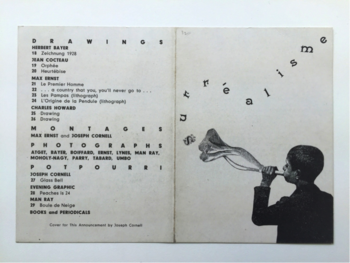Julien Levy

Julien Levy (22 January 1906, New York - 10 February 1981, New Haven, CT) was a pioneering New York art dealer of the 1930s and 1940s. He was introduced to the art world in Paris by Marcel Duchamp, whom he had met in New York in 1926. In Paris he met photographers and artists, including Man Ray, Berenice Abbot, and Joella Haweis, daughter of Dadaist muse Mina Loy, who became his wife. Upon his return to the United States, Levy worked briefly at the Weyhe Gallery before opening the Julien Levy Gallery at 602 Madison Avenue. In 1932, Levy mounted Surrealisme, which introduced the Surrealist art movement to New York.
Contents
Levy was born in 1906 in New York. He attended Harvard University, where he studied museum administration as a student of Paul Sachs. He did not complete his course of study, however, deciding instead to travel to France in 1927. There he met and befriended artists Man Ray, Marcel Duchamp and others, and was introduced to the work of French photographer Eugene Atget. It Atget’s photographs, that inspired him to become an art dealer. While in France, he also met his wife, Joella Haweis, and her mother, Mina Loy, who would eventually serve as his gallery representative in Paris.
When Levy returned to New York, he worked briefly in the print room of the Weyhe Gallery, as Carl Zigrosser’s assistant. At this time, he also became partial owner of the Atget photograph archive, which had been rescued by photographer Berenice Abbott from Atget’s studio just after his death in 1927. Levy mounted an exhibition of Atget photographs at Weyhe, and it was after this he decided to open his own gallery. Using money he inherited from his mother, Levy open his gallery in 1931. In 1937, he moved the gallery to 15 East 57th Street, and in 1943 he relocated again to 42 East 57th, where the gallery remained until it closed in 1949.
In the beginning, Levy exhibited and sold the work of American and European photographers, including Atget, Stieglitz, Nadar and Henri Cartier-Bresson, promoting photography as an art form, as Alfred Stieglitz had done. In 1932, Levy held the first Surrealism show in New York, displaying works from a variety of mediums, including photography, painting, sculpture, collage and books. This show introduced major artists of the Surrealist movement, most notably Salvador Dali, whose painting The Persistence of Memory Levy had purchased the previous year. In addition to promoting Dali’s work, Levy was the first New York dealer to exhibit the works of many important Surrealist-influenced artists, including Joseph Cornell, Frida Kahlo and Arshile Gorky.
After closing his gallery in 1949, Levy turned to teaching. He held teaching positions at Sarah Lawrence College and SUNY Purchase. (Source)
Publications
- Surrealism, New York: Black Sun Press, 1936, 191 pp [2]; facs.repr., New York: Arno, 1968; new ed., intro. Mark Polizzotti, New York: Da Capo Press, New York, 1995, viii+191 pp.
- Eugene Berman: A Biographical Sketch with an Index to His Paintings, New York: American Studio Books, 1947, xv+80 pp.
- Arshile Gorky, New York: Abrams, 1966, 235 pp.
- Memoir of an Art Gallery, New York: Putnam, 1977, 320+18 pp; new ed., intro. Ingrid Schaffner, Boston: Museum of Fine Arts, 2003. Schaffner's introduction.
Literature
- Judith Parker, "Art to Me is Almost Religion", Harvard Magazine, 1979.
- Ingrid Schaffner, Lisa Jacobs (eds.), Julien Levy: Portrait of an Art Gallery, MIT Press, 1998.
- Katherine Ware, Peter Barberie (eds.), Dreaming in Black and White: Photography at the Julien Levy Gallery, Yale University Press, 2006.